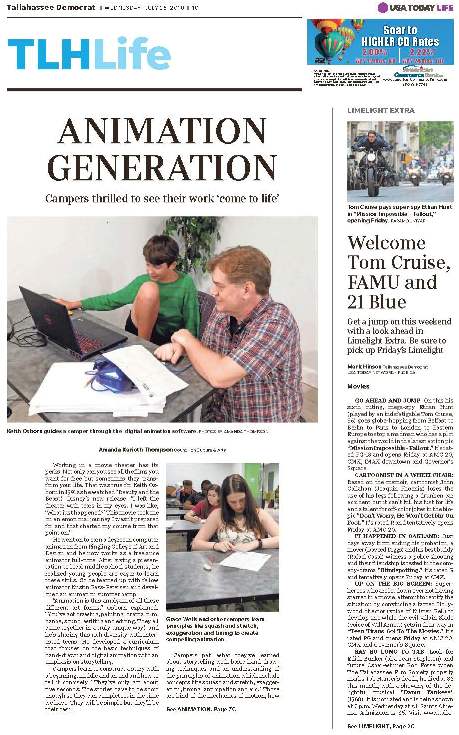 Working in a movie theater has its perks. Not only can you see all the films you want for free but sometimes they transform your life. That was true for Keith Osborn in 1991 as he watched “Beauty and the Beast,” Disney’s new release. “I left the theater with tears in my eyes. I was like, ‘What just happened?’ This movie took me on an emotional journey I wasn’t prepared for and that charted my course from that point on.”
Working in a movie theater has its perks. Not only can you see all the films you want for free but sometimes they transform your life. That was true for Keith Osborn in 1991 as he watched “Beauty and the Beast,” Disney’s new release. “I left the theater with tears in my eyes. I was like, ‘What just happened?’ This movie took me on an emotional journey I wasn’t prepared for and that charted my course from that point on.”
He went on to earn a degree in computer animation from Ringling College of Art and Design and he now works as a freelance animator full-time. After giving a presentation to local middle school students, he realized young people are eager to learn these skills. So he teamed up with fellow animator Kristin Bass-Petersen and developed an animation summer camp.
“Animation is this amalgam of all these different art forms,” Osborn explained. “You’ve got drawing, painting, drama, film, dance, sound, writing and editing. They all come together in a truly unique way,” and he’s sharing this rich diversity with interested teens. He developed a curriculum that focuses on the basic techniques of hand-drawn and digital animation with an emphasis on storytelling.
Campers learn to construct a story with a beginning, middle and an end and how to tell it concisely. “They’ve only got about five seconds. The stories have to be short enough so they can complete it in the time we have. They will be simple but they’ll be their own.”
Campers pair what they’ve learned about storytelling with basic hand-drawing techniques and an understanding of the principles of animation which include concepts like squash and stretch, exaggeration, timing, anticipation and arc. “Those are kind of the mechanics of motion, how things move in an appealing way. They’re fundamental to communicating your ideas. It’s like learning a language,” said Osborn.
The first challenge campers tackle is the bouncing ball exercise, a rite of passage for every animator. On separate pieces of paper, they hand-draw individual frames or images of a ball in motion. Using Stop Motion Studio, a downloadable app, the frames are recorded with a webcam that’s oriented downward.
“They put down their sheet of paper, we take a picture of it, they put down their next sheet of paper, we take a picture of it, all the while it’s on the big screen so everyone can see what’s going on,” Osborn explained. “They get to see it played back as soon as they’re done. It takes all of seconds to make a movie. As soon as it starts playing, their eyes light up. They’re seeing their work come to life for the first time. That, to me, is really exciting.”
It’s exciting to 17-year-old Grace Wells too. “The idea of making something, a story you can see, and then showing it to the world, there’s a sense of pride in that,” she said. Grace dreams of owning her own animation studio one day but until then, she’s grateful to attend this camp. “Having access to something like this gives me an opportunity that I don’t have at school. Most kids don’t.”
That’s why Osborn is keen to push the envelope and show campers digital techniques as well. Using a scaffolding approach, campers build on their existing hand-drawing skills and move their attention to computer animation software called Maya®. “The company that owns Maya has graciously offered the software to the students for free. We’ve installed it on their own laptops and they get to use it for three years,” said Osborn.
Read the rest of the story by visiting the Tallahassee Democrat
or read more by downloading the article here